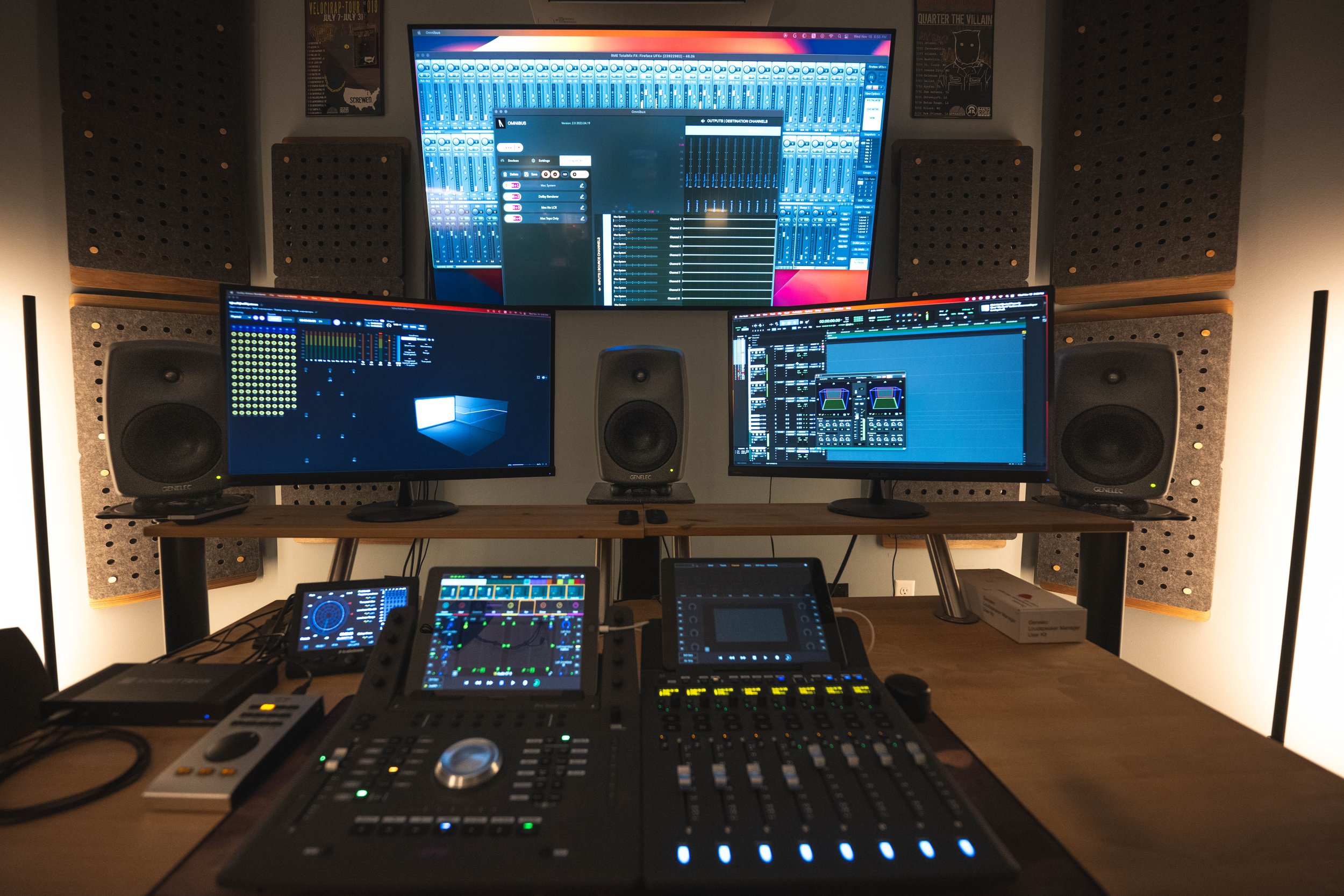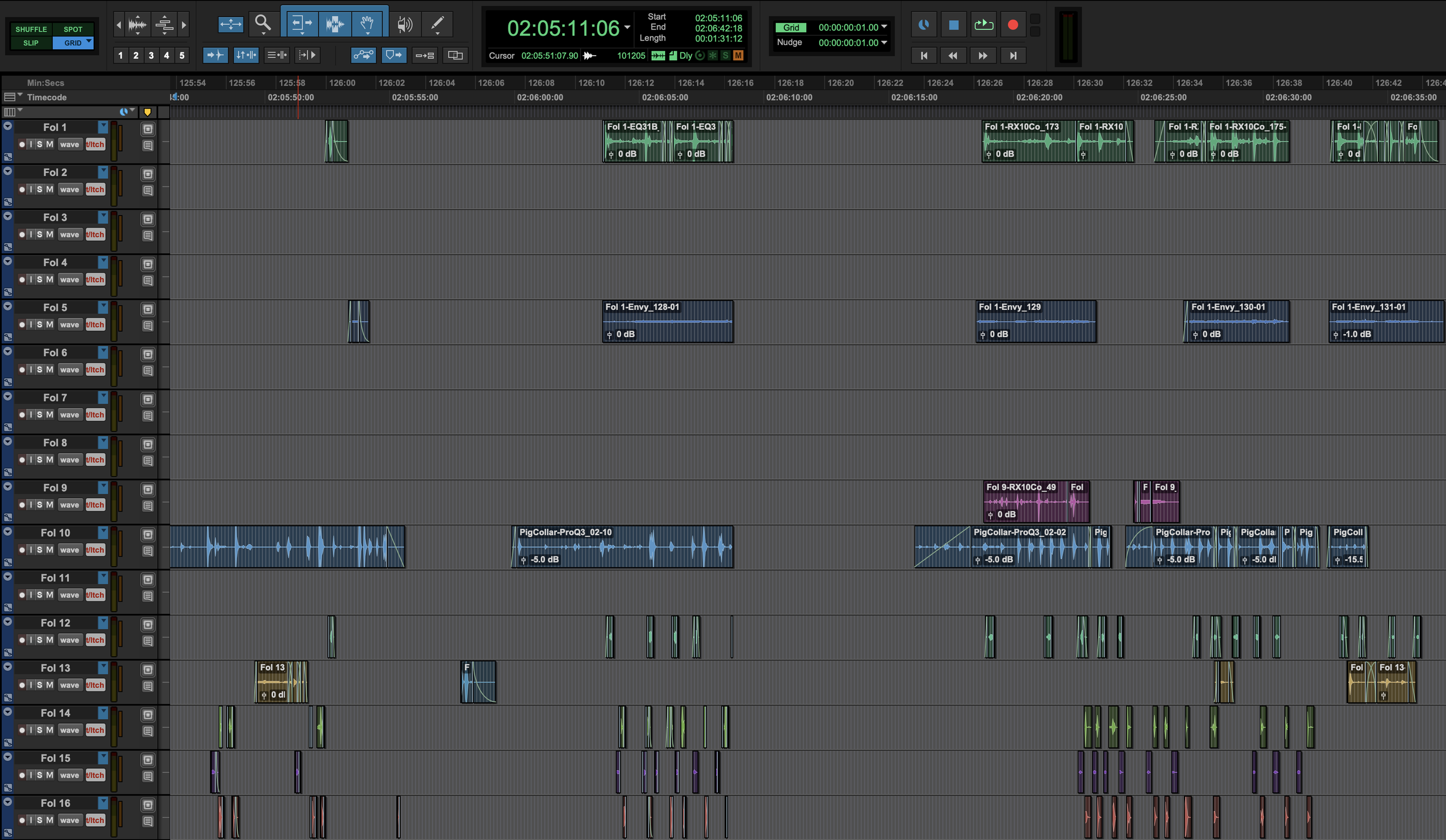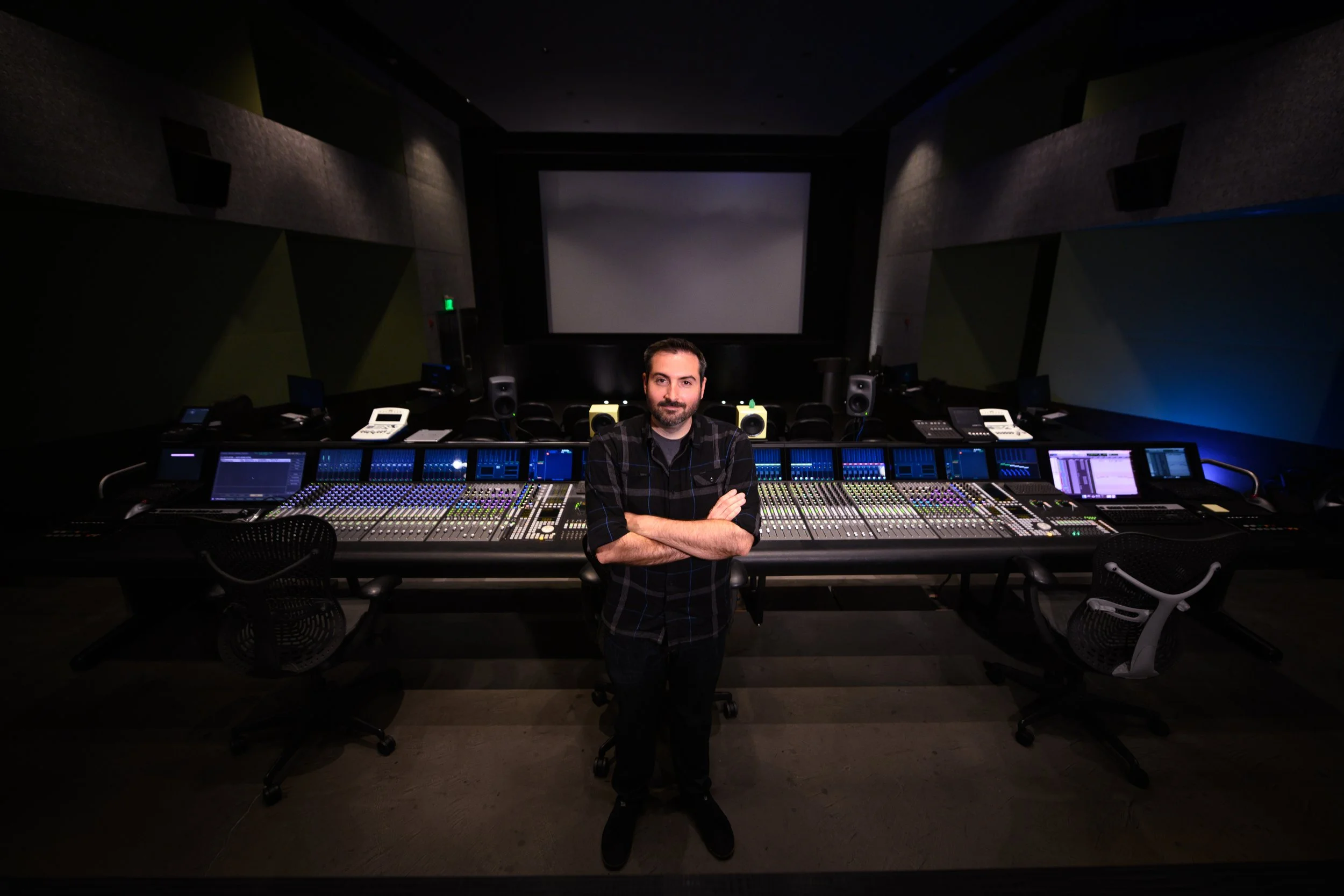The view from the mix position at Blackguard Sound Studios
Here at Blackguard Sound, we specialize in working with indie filmmakers. In fact, many of the films we have posted are collaborations with first-time filmmakers! We tend to see the same blind spots and pitfalls when it comes to sound and we hope that this blog post can clear up some of the mystery for potential clients and curious passers by. This primer assumes you’re trying to get international distribution for a feature-length film.
Phase one - Quoting / Initial Engagement
In this phase, we will ask to read the script. We will also ask to view a rough cut if there is one. We don’t care if VFX are missing, or if the picture isn’t colored, or if it doesn’t even have a LUT on it. We are used to looking at ugly, incomplete picture! This viewing is just to get a sense of the TRT, the quality of the production audio, and to establish any special needs that may need to be met. After the initial reading / viewing, we will submit an itemized quote that is customized based on your film. We will alert you to any potential future expenses in the rare event that’s applicable. Hopefully, there will be a contract for both parties’ protection that clearly lays out the scope of work, expectations, timelines, contingencies, and avenues for dispute resolution. This should all be pretty standard, but many indie filmmakers neglect these protections.
Note - This phase is how we, Blackguard Sound, do business. Not everyone will operate this way. As independent contractors we’re free to do business how we want and we’re not constrained by investors, managers, exorbitant business expenses, or other concerns that may lead others to operate in a different manner. This does not necessarily de-legitimize anyone else’s way of doing business. Many of the other phases to come are more ‘industry standard’ - this is just our take on the first phase.
Phase Two - Spotting / Picture Delivery Phase
This is the time for you to mention any key audio concerns, especially important scenes, and any audio-related creative ideas you hold dear. You might make references to existing works and we may watch those references for ideas. We will have a sound spotting session where we watch the film together and write down ideas or concerns as they occur. We will likely suggest custom field recordings, especially if the setting or locations are unique from a sonic perspective. We also might ask you for the composer’s contact info. It can be useful to inform the composer of technical requirements and open a creative dialog with them. It isn’t always necessary or possible, but a direct line of communication can lead to a better overall soundtrack.
We will provide technical requirements for the picture editor. The picture delivery for a sound department may be slightly different from what the editor is accustomed to. We will be very particular about frame rate, timecode, video codec, AAF (picture editor timeline) and other odds and ends. Typically, we want the movie broken into reels. In the days of film, there was a limit to how much time would fit on one reel. Even though we know you most likely didn’t shoot on actual film, we still like that workflow. It breaks the film into manageable chunks and if the timeline were to change it limits the damage to one reel (kind of like sealing off decks on the Titanic as it sinks). Typically, these reels will be 20-30 minutes long each, and can be broken up on a scene boundary or wherever makes sense from a story perspective.
Five Reels on a Pro Tools timeline.
Phase Three - Editorial Phase
Sound editorial for a narrative, feature-length film is a complicated process! Here’s a breakdown of each category:
Dialog Edit
The Dialog Editor will start by ingesting the picture editor’s timeline. They will sort through all the available microphones from the set and discard any that aren’t useful. They will separate the spoken dialog from any production sound effects. Next, they will sort the mics onto dialog tracks to smooth out the transitions between shots, so that the master shot smoothly transitions to the closeups with no noticeable jumps in sound quality. Then, they will bring the dialog volume levels up to industry standards and perform any necessary noise reduction - it’s usually a lot. Finally, they will sort through alternate takes if any lines were deemed to be unusable. At the end of this process they should have the dialog sounding pretty good and will provide a list of lines they’d like to propose for ADR.
About two minutes worth of a dialog edit in Pro Tools
Sound Effects Edit
The Sound Effects Editor will use an extensive library of sounds to populate the timeline with thousands of individual sounds ranging from backgrounds (aka ambiences) to doors, cars, gunshots, etc. They are trying to accurately recreate reality while adding some Hollywood flash. This involves way more intricate detail than most people would imagine.
One reel of backgrounds edited in Pro Tools
Sound Design
A Sound Designer is more likely to be employed on certain genre films like horror, science fiction, or fantasy. They are tasked with building highly customized sounds for more fantastic elements like creatures, gore, space ships, futuristic weaponry, magic, etc. This will require lots of creative experimentation, trial and error and subjective opinions. This role will most likely not be required on genres like drama or romance (provided the setting is not in some far-off historical period).
Sound Design PreDubs in Pro Tools
Phase Four - Recording Phase
Low budget independent films can benefit greatly from loads of custom recordings. It’s a relatively low-cost way to add tons of production value. In many cases, these items aren’t optional. Here are some typical examples.
Foley
Foley is the non-dialog sounds created by the characters in the film. Footsteps, clothing movements, and prop interactions that are often impossible to accurately record on set. For reasons unknown to us, many filmmakers will refer to the sum total of the sound effects as ‘foley’. That would be a misnomer. One key distinction: whereas sound effects are edited onto the timeline, foley is recorded in real time by a foley artist (performer) and foley mixer (recordist). You may be wondering - why not edit those sounds in? Why do they have to be custom recorded? A typical 90-minute film has approximately 3,000 foley spots! Custom recording these elements is MUCH faster than editing them in. Another important aspect to consider with foley is the M&E. We will discuss the M&E later when we explain deliverables but suffice it to say your movie will not get distribution without extensive foley recording!
Approximately 45 seconds of a Foley timeline in Pro Tools
ADR
Also known as dubbing or looping. This is where the actors come into the studio to re-record lines that have unfixable audio issues. It’s also an opportunity to add new lines to help propel the story forward or fix continuity issues. All we need is a shot where the actor’s lips aren’t visible and you can add just about anything! The actor will read their lines while watching themselves on screen and lip sync will be crucial! It can be tough to get the actors back into ‘on set’ mode so an experienced ADR recordist will also sometimes serve as a performance coach along with the director. Any ADR will need to be sonically matched with the production audio so it’s not obviously dubbed, which can take viewers out of the moment.
Loop Group / Crowd Walla
This may be required for films that have scenes of crowds, especially if there are specific call outs that need to happen. Imagine a scene where protestors are shouting slogans about something specific. Or a sporting event where crowds need to react to specific actions on the field. These types of crowd vocals are too specific for pre-existing sound libraries to be useful so they are often custom recorded.
Phase Five - Mix
The mix is where all of the elements come together. Upon completing the editorial and recording phases, there are potentially tens of thousands of little pieces of audio spread across hundreds of tracks. Certain genres may even exceed 1,000 audio tracks! All of these elements now need to be carefully blended together to create the detailed, realistic, and enormous sounding mix that movie-goers want to hear.
Pre Dubbing
We will meticulously focus on each of the above elements one at a time. The dialog comes first, since it is the only element with strict technical standards that must be adhered to. Once the dialog has been mixed, we can start folding in other layers until everything is accounted for. This can be a tedious process. We may play the same line of dialog 30 times in a row to get the EQ settings just right. Or we might play through the same intricate action scene 20 times, making sure every sound is panned to the exact right place in the theater. Typically, we do not need the filmmakers to be present for pre dubbing. We may send ‘WIP’ versions of the mix for review, but we’re mostly working in solitude at this point.
Final Mix
Typically, we’re about 90% mixed at this point and it’s sounding pretty good. It’s finally far enough along for you, the filmmaker, to come in to start giving your valued creative feedback. This stage is where we will work most closely with you and the rest of your creative team. You will sit on a comfy couch and watch as we play through, giving notes and feedback along the way. We will fix most things in real time and play it back for approval. In most cases, we will allocate one full day per reel so we can really dig in with the details. Then one additional day for last looks and final notes on the whole film. We will likely address hundreds of major and minor notes and that’s normal! At a certain point audio is subjective and we may not hear things exactly the same way. It’s your movie and we’re providing a service so we will usually defer to you on creative matters unless we strongly disagree based on our experience. We may push back a little harder on technical details since we’ll be on the hook for those.
Mix day on the Dub Stage
Phase Six - Assembly / Deliverables
Once the mix is complete, the reels need to be reassembled. We will handle that to make sure the reel transition is smooth and any music that hangs over the reel boundaries are handled properly. You will receive a handful of different files, all the full length of the film, in both surround sound (5.1 or 7.1) and in stereo. If your film was mixed in Dolby Atmos there will be an additional set of deliverables for that, too. Here’s the list:
Dialog Only Stem
Just the dialog. No music or effects. This might end up being useful if anyone needs isolated dialog for the trailer and it will be used to derive the QC report (more on that later).
Spectral image from iZotope RX of a Dialog Stem from a somewhat recent film
Effects Only Stem
Just the sound effects. No dialog or music. This is also most likely to be used for the trailer and there are also QC implications.
Sound Effects Stem - bonus points if you can tell what the sound is.
Music Only Stem
Just the music. No dialog or sound effects. This may be helpful for the trailer and for creating a music cue sheet in some cases. No QC implications here.
Music Stem from the same movie.
M&E
Music and Effects only. This is a version of the soundtrack with the dialog muted that is used for foreign language dubbing. They don’t want to have to recreate the whole soundtrack - just the dialog. This is where foley becomes extremely important. If you mute the dialog, you also mute any production sound effects that went with it. Those sounds now have to be present in the foley or the distributor will reject the film! Note - if you engage an audio post team to work on a festival film they may not provide a ‘fully filled’ M&E, since that deliverable is not required for festival submissions. Make sure your contract clearly specifies which deliverables they are responsible for…delivering. If an M&E isn’t specified and you end up needing one later, be prepared to pay an additional fee. We have been contracted to complete just the M&E for festival films that unexpectedly got a distro deal. Of course, we charge for this service and so should your existing sound department if it wasn’t specified from the beginning.
Printmaster
This is the full mix of everything and the main event. This is what US viewers will see in the theater or on their screens at home.
Phase Seven - Completion
Quality Control (QC)
Before the distributor buys your film, they will employ a 3rd party post facility to run QC checks on the film. They will meticulously analyze the film, moment by moment, looking for technical mistakes. They are checking that sync pops are present, sound effects and dialog are in perfect sync with the picture, sounds are playing out of the correct stems, dialog is at a reasonable quality / intelligibility level, and that the M&E is ‘fully filled’ with foley and sound effects to satisfy the needs of the international dub. That is, everything that could conceivably make a sound has to have a sound present in the mix. There are more technical details that go into this, but let us worry about that! It’s been a long time since we delivered a film that had any QC issues, but with so many moving parts it’s possible for something to slip through the cracks. We will be responsible for any audio related QC failures and will submit a corrected version of the film if required. Note that your video post department will have to run this gauntlet for their work as well.
A lightly redacted QC report from many years ago.
That should conclude our work on the film. Any lingering payments will hopefully be made once QC is passed and the distributor is satisfied. The total time elapsed from phase one to phase seven varies for each film, but is usually 3-4 months. Any period longer than that on an indie film is usually due to delays outside of our control (like waiting for score / VFX to be completed or waiting for music rights to clear). This will have represented many hundreds of person-hours of labor which, again, will vary widely based on the needs of the project.
Conclusion
That’s a wrap on chapter one! We will add more chapters in the future. Of course, this isn’t 100% exhaustive but hopefully it’s an eye-opening start. We aim to be the best audio post choice for indie filmmakers in Orlando, FL and beyond. Please email us at blackguardsmg@gmail.com for specific questions about your film.










